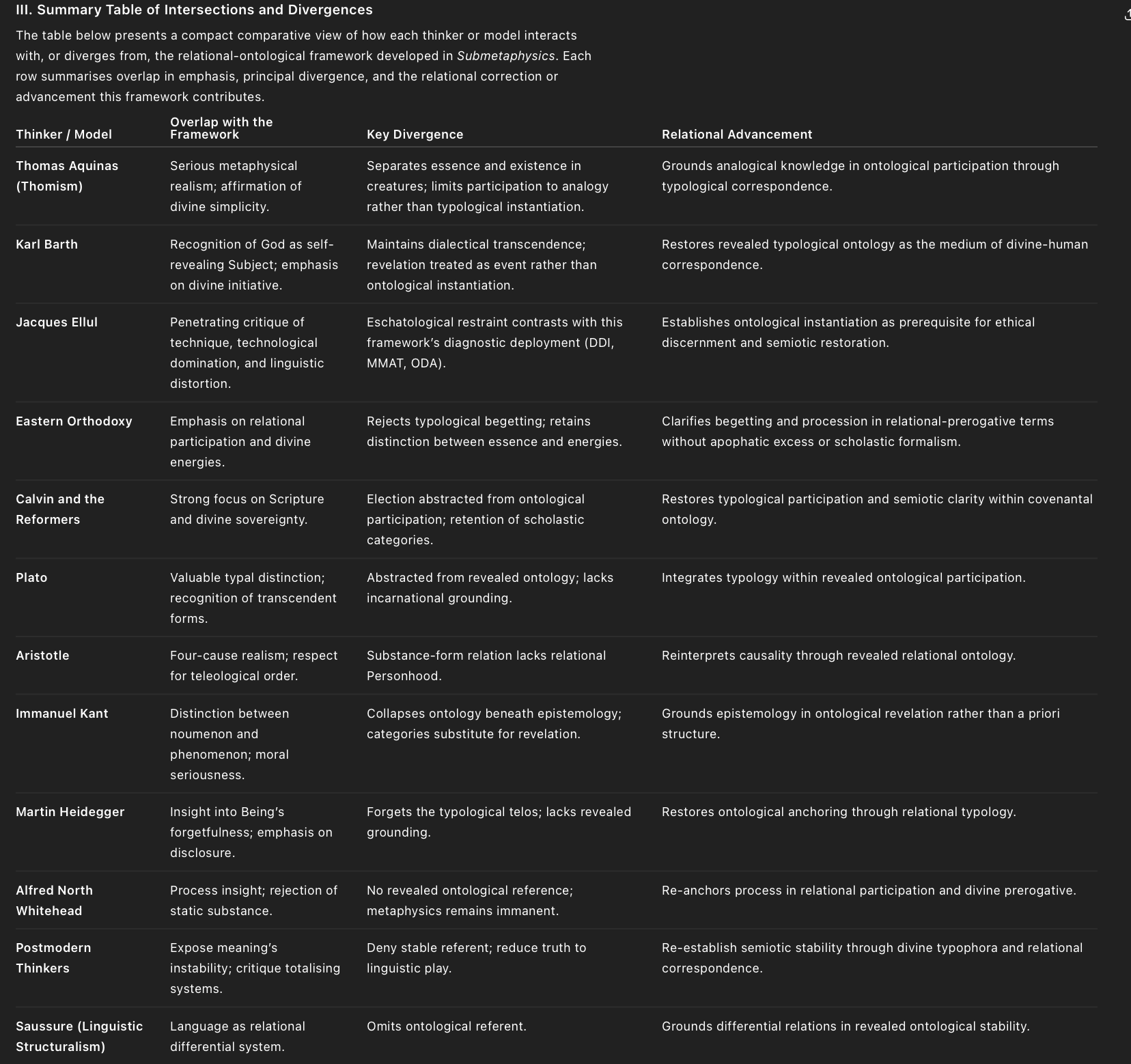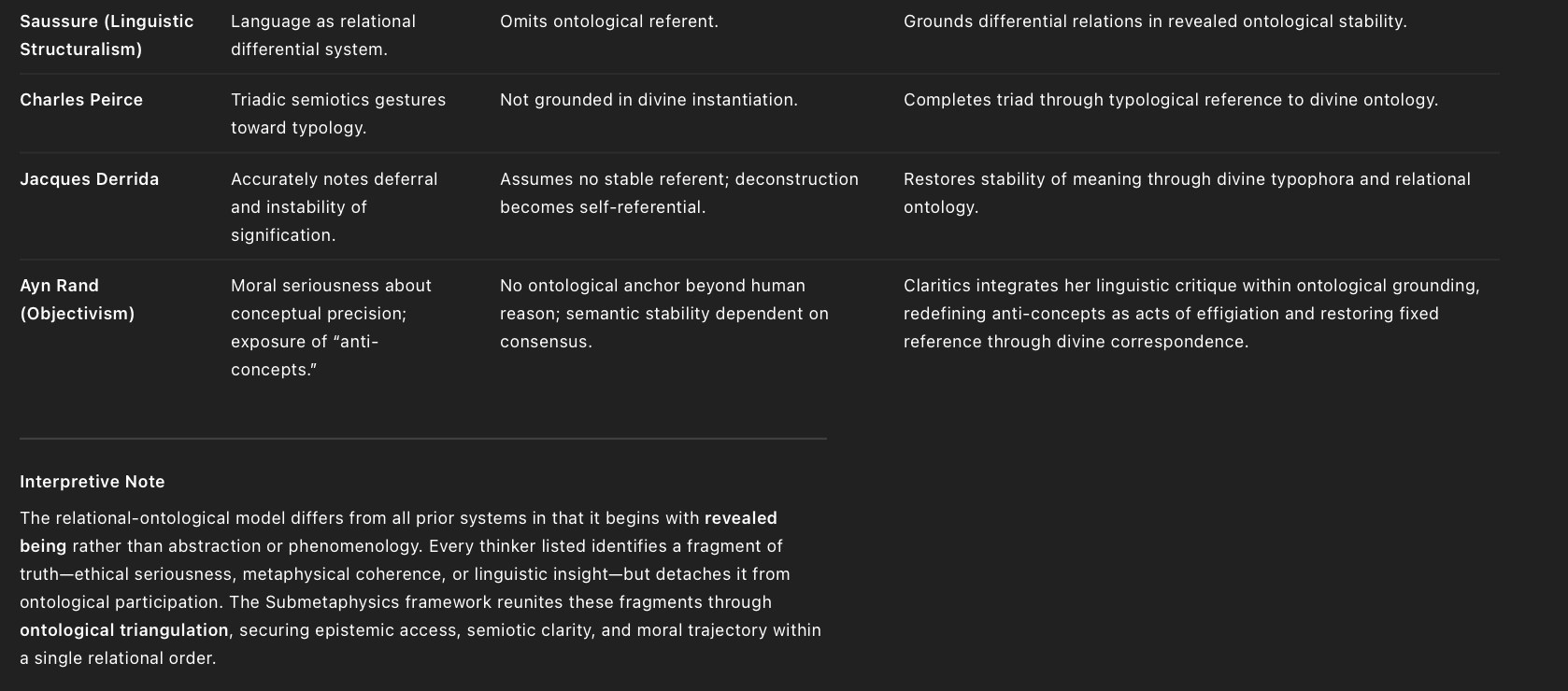This appendix exists not merely to trace historical ideas or compare theological frameworks, but to clarify this framework’s distinct position and prevent misclassification. Each thinker or model is assessed through ontological triangulation, a method that evaluates proximity to relational-correspondent truth. This involves examining four critical dimensions:
Ontological grounding – Does the model begin with or derive from revealed being?
Epistemic structure – How does the model account for truth, access, and justification?
Semiotic clarity – Does the model preserve referential integrity in its use of language and symbols?
Moral trajectory – What posture or orientation toward divine confrontation does the model promote?
Together, these axes allow for a rigorous and charitable evaluation—highlighting where overlap exists, where distortion enters, and where realignment would be necessary for coherence with the revealed typological ontology advanced in this framework.
Shared metaphysical seriousness and acknowledgment of divine simplicity.
Divergence: Thomism separates essence and existence in creatures; the relational model insists on ontological participation via typological begetting.
Thomism affirms analogia entis; this model grounds analogical knowledge in typophoric relational correspondence.
Overlap: Recognition of God as self-revealing Subject.
Divergence: Barth maintains dialectical transcendence; this model insists on revealed typological instantiation.
Barth avoids natural theology; this model critiques both natural and dialectical theology for neglecting ontological clarity.
Overlap: Profound critique of technique, technological dominance, and linguistic distortion.
Divergence: Ellul’s eschatological restraint contrasts with this model’s active diagnostic deployment (e.g., DDI, MMAT, ODA).
Ellul’s theology of presence lacks typological ontology; this framework demands ontological instantiation as prerequisite for ethical discernment.
Convergence: Emphasis on mystery, relational participation, and divine energies.
Divergence: Rejection of the essence–energies distinction in favor of substantive ontohomogeneity and distinct ontorelationality.
This model clarifies begetting and procession in relational-prerogative terms, avoiding both apophatic excess and scholastic formalism.
Partial recovery: Emphasis on Scripture and God's sovereignty.
Limitation: Failure to ontologically distinguish election from instantiation; retention of scholastic categories.
Absence of semiotic critique and typophoric clarity weakens reformative potential.
Plato: Valuable in typal distinction, but abstracted from revealed ontology.
Aristotle: Four-cause framework acknowledged, but ungrounded in relational Personhood.
Kant: Misplaces ontology beneath epistemology—categorical structures substitute for typological encounter.
Heidegger: Insight into Being’s forgetfulness; however, lacks teleological typology and divine grounding.
Whitehead: Process insight without revealed anchoring; misplaces reality into flux.
Postmodern theorists: Collapse meaning into relativism; this model restores fixed relational ontology.
II.6.i. Ayn Rand (Objectivism) :
Convergence: Recognises conceptual corruption as moral decay (anti-concept analysis). Defends clarity, precision, and non-contradiction as moral imperatives.
Divergence: Lacks a transcendent ontological anchor; meaning depends on rational abstraction and empirical reference. Appeals to dictionary or consensus usage as final arbiter of meaning, leaving semantic stability vulnerable to drift.
Relational Assessment:
II. 7. Summary
None of the compared models wholly integrates the four triangulation axes. While some recover ontological seriousness or moral posture, they often collapse semiotic integrity or subordinate ontology to epistemology. Only the relational-ontological framework developed herein maintains coherence across all four axes—anchored in divine prerogative, typal instantiation, and moral confrontation.
Saussure: Language as relational differential system, but lacks ontological reference.
Peirce: Triadic model points toward typology, but not grounded in divine instantiation.
Derrida: Deconstruction rightly sees instability in signs—but wrongly assumes no stable referent.
This model restores semiotic stability via divine typophora and relational correspondence.
The following table provides a compact view of how each thinker or model intersects with, or diverges from, the relational ontological framework developed in this project.


